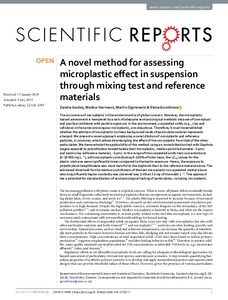| dc.contributor.author | Gerdes, Zandra | |
| dc.contributor.author | Hermann, Markus | |
| dc.contributor.author | Ogonowski, Martin | |
| dc.contributor.author | Gorokhova, Elena | |
| dc.date.accessioned | 2021-02-08T20:20:43Z | |
| dc.date.available | 2021-02-08T20:20:43Z | |
| dc.date.issued | 2019 | |
| dc.identifier.citation | Gerdes, Z.; Hermann, M.; Ogonowski, M. et al. (2019) A novel method for assessing microplastic effect in suspension through mixing test and reference materials. Scientific Reports, 9:10695, 9pp. DOI: https://doi.org/10.1038/s41598-019-47160-1 | en_US |
| dc.identifier.uri | http://hdl.handle.net/11329/1510 | |
| dc.identifier.uri | http://dx.doi.org/10.25607/OBP-1010 | |
| dc.description.abstract | The occurrence of microplastic in the environment is of global concern. However, the microplastic
hazard assessment is hampered by a lack of adequate ecotoxicological methods because of conceptual
and practical problems with particle exposure. In the environment, suspended solids (e.g., clay and
cellulose) in the same size range as microplastic, are ubiquitous. Therefore, it must be established
whether the addition of microplastic to these background levels of particulate material represents
a hazard. We present a novel approach employing a serial dilution of microplastic and reference
particles, in mixtures, which allows disentangling the effect of the microplastic from that of the other
particulates. We demonstrate the applicability of the method using an immobilization test with Daphnia
magna exposed to polyethylene terephthalate (test microplastic; median particle diameter ~5 μm)
and kaolin clay (reference material; ~3 μm). In the range of the suspended solids test concentrations
(0–10 000 mg L−1), with microplastic contributing 0–100% of total mass, the LC50 values for the
plastic mixtures were significantly lower compared to the kaolin exposure. Hence, the exposure to
polyethylene terephthalate was more harmful to the daphnids than to the reference material alone. The
estimated threshold for the relative contribution of the test microplastic to suspended matter above
which significantly higher mortality was observed was 2.4% at 32 mg of the solids L−1. This approach
has a potential for standardization of ecotoxicological testing of particulates, including microplastic. | en_US |
| dc.language.iso | en | en_US |
| dc.rights | Attribution 4.0 International | * |
| dc.rights.uri | http://creativecommons.org/licenses/by/4.0/ | * |
| dc.subject.other | Microplastics | en_US |
| dc.subject.other | Particulate matter | en_US |
| dc.subject.other | Suspended solids | en_US |
| dc.title | A novel method for assessing microplastic effect in suspension through mixing test and reference materials. | en_US |
| dc.type | Journal Contribution | en_US |
| dc.description.refereed | Refereed | en_US |
| dc.format.pagerange | 9pp. | en_US |
| dc.identifier.doi | https://doi.org/10.1038/s41598-019-47160-1 | |
| dc.subject.parameterDiscipline | Parameter Discipline::Environment::Anthropogenic contamination | en_US |
| dc.bibliographicCitation.title | Scientific Reports | en_US |
| dc.bibliographicCitation.volume | 9 | en_US |
| dc.bibliographicCitation.issue | Article 10695 | en_US |
| dc.description.sdg | 14 | en_US |
| dc.description.maturitylevel | TRL 4 Component/subsystem validation in laboratory environment | en_US |
| dc.description.bptype | Manual (incl. handbook, guide, cookbook etc) | en_US |
| obps.contact.contactemail | elena.gorokhova@aces.su.se | |
| obps.resourceurl.publisher | https://www.nature.com/articles/s41598-019-47160-1 | en_US |
 Repository of community practices in Ocean Research, Applications and Data/Information Management
Repository of community practices in Ocean Research, Applications and Data/Information Management

